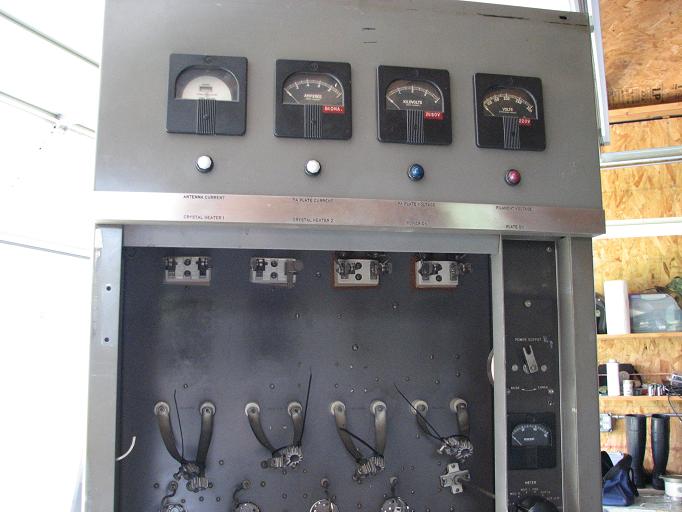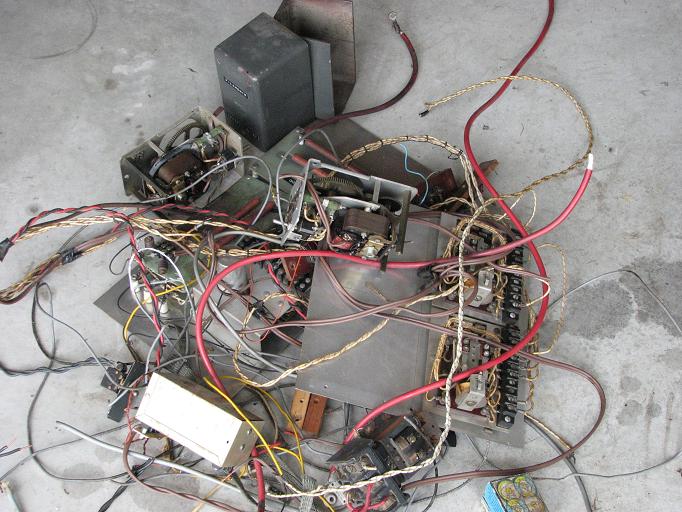The RCA BTA-1MX AM Transmitter
This transmitter came from WLAN 1390 in Lancaster Pennsylvania and was provided as payment for moving a Broadcast Electronics AM-6 to the Dover market and a very heavy Collins 5 kW pig to the Harrisburg market.
For a YouTube video of Al and I moving this thing look at : YouTube - RCA-BTA1 Transmitter Transport
The transmitter was very dirty when I got it


Internal views after the transformer, tubes and blower were removed.

Parts of the two different remote control system installed over time
The transmitter getting ready to be washed. I use the garden hose, laundry detergent and a leaf blower for drying and find this to be real effective
Everything nice and clean! The dirtier they are the better they clean up
And now moving on to component testing. This is one of the two identical quad secondary filament transformers that looked questionable
Those little halogen headlights for cars make good test loads for transformers. your always supposed to change them in pairs so now you know what to do with the one that still works!
After much pushing and pulling the transmitter is in its new home!
The modulator compartment and the filament supplies.
More stuff has been moved around to accommodate the RCA
rebuilt driver tank and new layout for the PA tank for 1885 Kc. The driver tank coil broke apart when I was attempting to tune it. Had to unwind all the coil from the ceramic and then wind the coil over again. Did give good opportunity to clean all the components involved in the process.
Audio driver and couplers. The RCA use 807 tubes for everything, the oscillator, audio drivers and buffers and RF drivers. The audio drivers are cathode coupled to the 833 modulator tubes so their is a minimum of transformers.
Transmitter Control System
Unlike broadcast service where the transmitter was turned on and left running several new things have to happen for Armature service. First a Transmit Receive relay has to be installed to switch the antenna between the transmitter and receiver, second a time delayed relay has to apply plate voltage to the transmitter after the antenna is transferred and last but not least the plate relay has to be released when the transmitter goes into standby before the Transmit Receive relay is switched back to receive.
This panel controls the existing plate contactor IK2 via terminals 9A and 10A and a new 120 volt AC RF relay installed in the top of the transmitter for the antenna switching function. The circuit uses one time delay relay for operating the plate contactor and a second relay with a time hold function to provide a half second delay for the T/R relay. Inside the metal box is the 24 volt power supply and a fourth RF relay that grounds the input to the receiver and mutes its audio in the transmit mode.
Could have used more modern technology but wanted to use relays, something not right about using a PLC to control a sixty year old transmitter.
Now that all the control is working its time to play with the output tank! pushing the oscillator, driver and grid inputs to the PA was easy the new challenge is to build a output for the PA that is efficient and wont produce spurious. One of the first transmitters I built years ago developed almost as much power on the second and third harmonic as on the carrier.
This is the way I have it configured now and with using 1,300 volts on the plate am drawing around 300 mills and developing about 325 watts output with a indirect power of 390 watts, that's a efficiency of over 80%!
The Audio Chain, a AM Volumax and a Shure Microphone mixer. What more do you need!
The transmitter is now operating on 1.885 running about 330 watts of carrier
The Volumax is doing a great job of limiting negative peaks and keeping positive around 100%
The first QSO was with Al, K3TKJ on February 6th 2011
YouTube Videos of transmitter in opperation:
http://www.youtube.com/watch?v=LETZZRauMbQ
YouTube Videos of transmitter being transported from Lancaster and moved into shop:
http://www.youtube.com/watch?v=Xr_dGrM6wvY
http://www.youtube.com/watch?v=abX5ha3957Q
Sep2014
Return to Rays Web Page